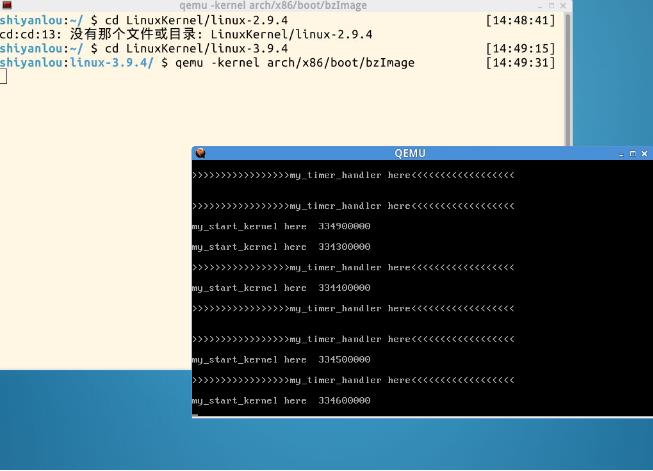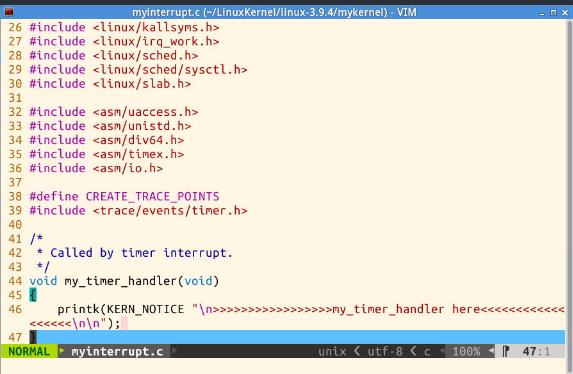linux及安全第二周总结——20135227黄晓妍
Posted note0710
tags:
篇首语:本文由小常识网(cha138.com)小编为大家整理,主要介绍了linux及安全第二周总结——20135227黄晓妍相关的知识,希望对你有一定的参考价值。
实验部分:
首先运行结果截图



代码分析:
Mypcb.h
/*
* linux/mykernel/mypcb.h
*
* Kernel internal PCB types
*
* Copyright (C) 2013 Mengning
*
*/
#define MAX_TASK_NUM 4
#define KERNEL_STACK_SIZE 1024*8
/* CPU-specific state of this task */
struct Thread {
unsigned long ip;
unsigned long sp;
};
typedef struct PCB{
int pid;//进程的id用pid表示
volatile long state; /* -1 unrunnable, 0 runnable, >0 stopped */ //进程状态,-1等待,0运行,>0停止
char stack[KERNEL_STACK_SIZE];//堆栈
/* CPU-specific state of this task */
struct Thread thread;
unsigned long task_entry;//入口
struct PCB *next;//进程用链表的形式链接
}tPCB;
void my_schedule(void);
mymian.c
/*
* linux/mykernel/mymain.c
*
* Kernel internal my_start_kernel
*
* Copyright (C) 2013 Mengning
*
*/
#include <linux/types.h>
#include <linux/string.h>
#include <linux/ctype.h>
#include <linux/tty.h>
#include <linux/vmalloc.h>
#include "mypcb.h"
tPCB task[MAX_TASK_NUM];
tPCB * my_current_task = NULL;//当前task指针
volatile int my_need_sched = 0;//是否需要调度的标识
void my_process(void);
void __init my_start_kernel(void)
{
int pid = 0;
int i;
/* Initialize process 0*/
task[pid].pid = pid;//初始化0号进程
task[pid].state = 0;/* -1 unrunnable, 0 runnable, >0 stopped *///状态是运行
task[pid].task_entry = task[pid].thread.ip = (unsigned long)my_process;//入口是myprocess
task[pid].thread.sp = (unsigned long)&task[pid].stack[KERNEL_STACK_SIZE-1];//堆栈栈顶
task[pid].next = &task[pid];//刚启动时只有它自己,所以next也指向它自己
/*fork more process *///创建更多进程
for(i=1;i<MAX_TASK_NUM;i++)
{
memcpy(&task[i],&task[0],sizeof(tPCB));//把0号进程的状态复制给下一个进程
task[i].pid = i;//初始化刚创建的进程
task[i].state = -1;
task[i].thread.sp = (unsigned long)&task[i].stack[KERNEL_STACK_SIZE-1];//新进程的堆栈
task[i].next = task[i-1].next;//指向下一个进程
task[i-1].next = &task[i];//新进程放在链表的尾部
}
/* start process 0 by task[0] *///开始执行0号进程
pid = 0;
my_current_task = &task[pid];
asm volatile(//此处为嵌入式汇编代码
"movl %1,%%esp\n\t" /* set task[pid].thread.sp to esp *///将thread.sp复制给esp
"pushl %1\n\t" /* push ebp *///当前栈是空的,esp=ebp,所以压栈sep就是压栈ebp
"pushl %0\n\t" /* push task[pid].thread.ip *///将ip压栈
"ret\n\t" /* pop task[pid].thread.ip to eip *///将ip弹栈,即myprocess的头部,也就是0号进程正式开始启动
"popl %%ebp\n\t"//弹栈
:
: "c" (task[pid].thread.ip),"d" (task[pid].thread.sp) /* input c or d mean %ecx/%edx*///c是%0,即为ip;d是%1,即为sp.
);
} //内核初始化完成,0号进程开始执行
void my_process(void)
{
int i = 0;
while(1)
{
i++;
if(i%10000000 == 0)
{
printk(KERN_NOTICE "this is process %d -\n",my_current_task->pid);
if(my_need_sched == 1) //1为需要调度
{
my_need_sched = 0;
my_schedule();
}
printk(KERN_NOTICE "this is process %d +\n",my_current_task->pid);
}
}
}
Myinterrupt
/*
* linux/mykernel/myinterrupt.c
*
* Kernel internal my_timer_handler
*
* Copyright (C) 2013 Mengning
*
*/
#include <linux/types.h>
#include <linux/string.h>
#include <linux/ctype.h>
#include <linux/tty.h>
#include <linux/vmalloc.h>
#include "mypcb.h"
extern tPCB task[MAX_TASK_NUM];
extern tPCB * my_current_task;
extern volatile int my_need_sched;
volatile int time_count = 0;
/*
* Called by timer interrupt.
* it runs in the name of current running process,
* so it use kernel stack of current running process
*/
void my_timer_handler(void)//时间片切换
{
#if 1
if(time_count%1000 == 0 && my_need_sched != 1)
{
printk(KERN_NOTICE ">>>my_timer_handler here<<<\n");
my_need_sched = 1;//调度
}
time_count ++ ;
#endif
return;
}
void my_schedule(void)//
{
tPCB * next;//下一个进程模块
tPCB * prev;//正在执行的进程模块
if(my_current_task == NULL
|| my_current_task->next == NULL)
{
return;
}
printk(KERN_NOTICE ">>>my_schedule<<<\n");
/* schedule */
next = my_current_task->next;
prev = my_current_task;
if(next->state == 0)/* -1 unrunnable, 0 runnable, >0 stopped *///切换进程
{
/* switch to next process */
asm volatile(
"pushl %%ebp\n\t" /* save ebp */
"movl %%esp,%0\n\t" /* save esp *///存到内存的prev->thread.sp
"movl %2,%%esp\n\t" /* restore esp *///存到内存的next->thread.sp
"movl $1f,%1\n\t" /* save eip */ //标号1: 的位置放在内存的prev->thread.ip
"pushl %3\n\t" //存到内存的next->thread.ip
"ret\n\t" /* restore eip */
"1:\t" /* next process start here */
"popl %%ebp\n\t"
: "=m" (prev->thread.sp),"=m" (prev->thread.ip)
: "m" (next->thread.sp),"m" (next->thread.ip)
);
my_current_task = next;
printk(KERN_NOTICE ">>>switch %d to %d<<<\n",prev->pid,next->pid);
}
Else//切换到新进程
{
next->state = 0;
my_current_task = next;
printk(KERN_NOTICE ">>>switch %d to %d<<<\n",prev->pid,next->pid);
/* switch to new process */
asm volatile(
"pushl %%ebp\n\t" /* save ebp */
"movl %%esp,%0\n\t" /* save esp */
"movl %2,%%esp\n\t" /* restore esp */
"movl %2,%%ebp\n\t" /* restore ebp */
"movl $1f,%1\n\t" /* save eip */
"pushl %3\n\t"
"ret\n\t" /* restore eip */
: "=m" (prev->thread.sp),"=m" (prev->thread.ip)
: "m" (next->thread.sp),"m" (next->thread.ip)
);
}
return;
}
总结部分:
本周要点:
- 计算机的三大法宝:存储程序计算机;函数调用堆栈;中断机制
- 堆栈
最原始的计算机是没有堆栈的概念的,出现高级语言以后才有了堆栈。堆栈是记录路径和参数的空间。
函数调用框架
传递参数(只适用于32位的x86)
保存返回地址
提供局部变量空间
3.堆栈寄存器
esp,堆栈栈顶指针,stack pointer
eip, 堆栈基址指针,base pointer
4.堆栈操作
push,压栈减4字节
pop,弹栈加4字节
5.其他寄存器
eip,不管是顺序执行,还是跳转,分支,都总是指向下一条应该执行的语句。
call,将当前eip的值压栈,并将eip的值改为函数入口的下一条指令的地址值。
ret,将eip的值弹栈放入eip中。
6.建立函数堆栈框架
push %ebp
movl %esp,%ebp
拆除函数堆栈框架
movl %ebp.%esp
pop %ebp
7.重点理解myinterruput.c里进程切换的代码。(切换进程指的是下一个切换上执行的进程)
分成两种情况,第一种是切换到的进程是执行过的进程,第二种是切换到的进程是新进程。首先第一种,先将当前进程的ebp压栈,然后将当前进程的栈顶指针esp保存到链表结构当前进程prev->thread.sp中,再将链表中切换的进程的next->thread.sp 复制给栈顶指针esp.将链表中当前进程prev->thread.ip存入函数的入口的值,再将切换进程的next->thread.ip压栈。然后第二种,先建好链表,再执行上述过程。
以上是关于linux及安全第二周总结——20135227黄晓妍的主要内容,如果未能解决你的问题,请参考以下文章